In today’s report– Chart: What’s stopping the aquaculture revolution?
Markets: Symbrosia has raised $7 million in new funding.
Epic: Development of spirulina for the manufacture and oral delivery of protein therapeutics
Conference Highlights: London Tech Week Synthetic Biology
Around the web: KTH researchers Joana Fonseca and Sriharsha Bhat have founded the spin-off Knowcean together.

“It’s so exciting to see so many new investors come into the aquaculture space, but there needs to be an alignment towards long-term value” — Amy Novogratz, Managing Partner, Aqua-Spark
Dear algae technologists,
Hello and welcome to The Paxtier Report for the period 150622 – 220622!
Did you know that the Sargasso Sea, located entirely within the Atlantic Ocean, is the only sea without a land boundary?
Instead, it’s surrounded by ocean currents and is named after the free-floating seaweed Sargassum, which can be found reproducing vegetatively on its high seas.
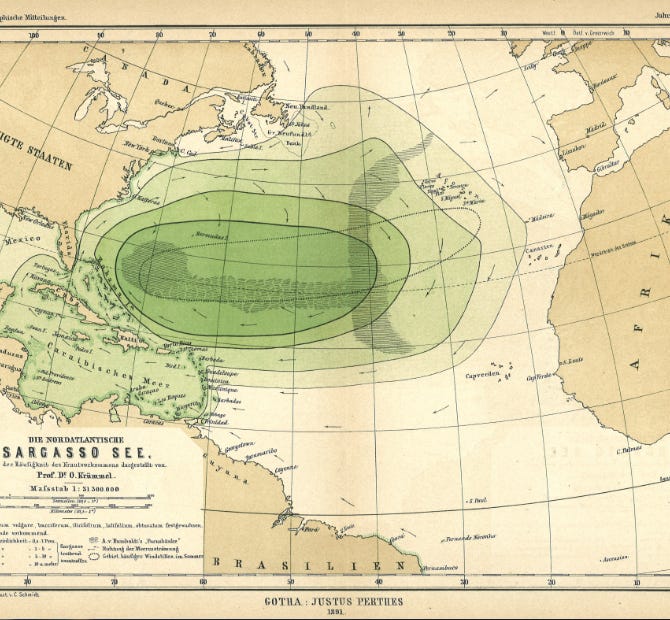
Columbus first documented his encounters with Sargassum in his expedition diaries in 1492. In these journals, he describes how this species threatened the safety of his ships by concealing lethal coral reefs.
Markets and Investing
🐟What’s stopping the aquaculture revolution?
Last week, Maggie Fried from CREO’s Oceans, Seafood, and Aquaculture Investor Consortium (OSAIC) made some interesting points during her speech at the Blue Food Innovation Summit 2022.
But it was her damning evaluation of the aquaculture fund ecosystem which made headlines. Find out why below:
Who are OSAIC?
Established in 2020, OSAIC is a group of 35 investors looking to drive more capital into blue foods and blue tech “by working together on dealflow, diligence information and co-investment.”
At present, the global consortium consists of 30+ family offices and funds. And since their inception, they’ve managed to deploy around $200 million into sustainable oceans, aquaculture, and seafood investments (see the breakdown in figure 1).
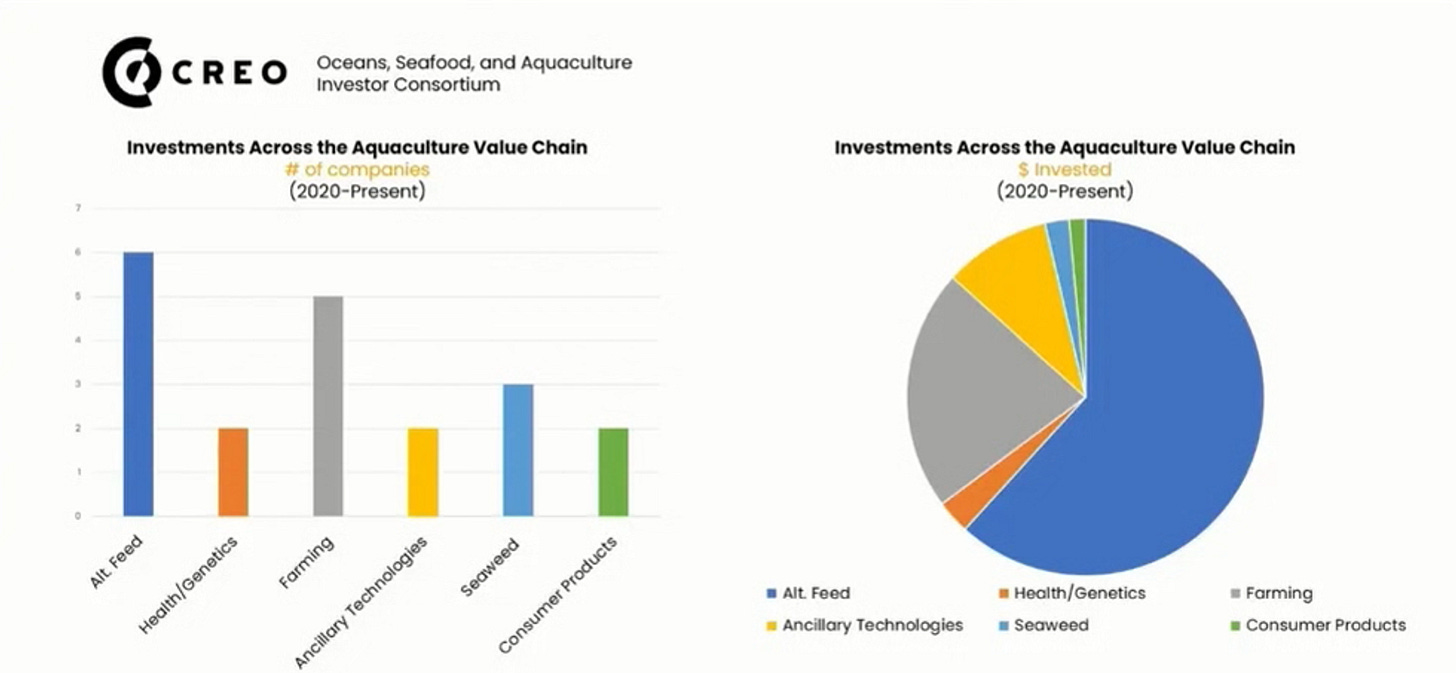
But this doesn’t even scratch the surface…
And despite the amazing selection of investors operating in aquaculture (as outlined by OSAIC in figure 2), Fried didn’t hold back with her review:
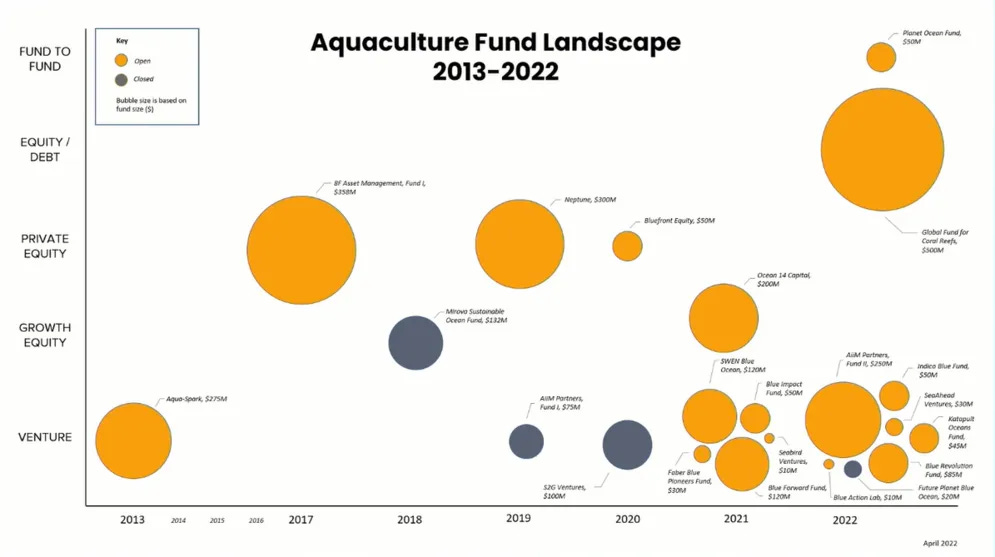
Here’s what she had to say:
If you look at the Towards a blue revolution report that the Nature Conservancy and Encourage Capital put out in 2019, they estimated that – to meet the demand for aquaculture – we would annually need $12-25 billion [invested] just in aquaculture infrastructure. That doesn’t even include the upstream and downstream part of the supply chain. So clearly, we’re not even close to the amount of capital we need to truly build this sector.
And from a fund differentiation standpoint:
Will there be enough high quality venture opportunities in this space for all of these funds to have a differentiated pipeline and be able to get the venture returns that they need?
Do we have the investors who are going to come in and write the larger cheques after those companies scale? Do we have investors who will come in and invest in infrastructure and debt financing?
No – in my opinion, which is problematic because it means we might be building out a non-robust, very lopsided supply chain. And these areas that are perhaps less sexy – processing, and cold storage for example, are not receiving the capital that they need. Consequently, when we scale production, we’ll have this ‘missing middle’ part of the supply chain that’s being underinvested in.”
But it’s not all doom and gloom… Particularly when it comes to seaweed
Here’s what Fried shared:
When I started this role in 2020 I had maybe one or two investors who were interested in seaweed. Now every single one of them, regardless of their strategy, is looking at it…
And there you have it folks. Once again… all roads lead back to algae.
✂️Algae Market Snippets
Some other big moves this week:
- Bon Natural Life Limited announced that it has launched a new cruciferous vegetable based probiotic powder drink that could potentially inhibit the proliferation of Helicobacter pylori and help regulate the digestive system. These patented probiotics mix sulforaphane, a chemical compound extracted from broccoli, and fucoidan, a compound extracted from seaweed. (Read more HERE.)
- Symbrosia, a U.S.-based startup that aims to reduce livestock methane emissions through its seaweed feed additive, has raised $7 million in new funding. After two years of research on seaweed breeding and cultivation technology, Symbrosia has developed strains that are significantly more productive, potent and resilient than wild populations. The company will use the capital to scale production of these breakthrough seaweed strains by orders of magnitude and bring their livestock feed additive, SeaGrazeTM, to market. (Read more HERE).
- Last week, Northwest Florida Water Management District and the US EPA, in partnership with AECOM, UF/IFAS and May Nursery, showcased the progress in their million dollar collaboration. In this project, the team cleans lakes by harvesting algae, and recovers the carbon, nitrogen, and phosphorus for use in bio products like fertilisers, fuels and consumer products. The mobile algae harvesting unit can process 200 gallons of algae laden water per minute, resulting in nearly a quarter million gallons of water cleaned per day. (Read more HERE).
- Pond Technologies Holdings Inc, announced it has agreed to a non-exclusive memorandum of understanding (“MOU”) with technology solutions company SEM Energy Ltd. (“SEM”). Headquartered in Aberdeen, Scotland, SEM is a sustainable technology solutions company that collaborates with stakeholders across the agriculture, aquaculture, distillery and biogas markets to implement tailored end-to-end solutions for the treatment of waste products and wastewater, the recovery of nutrients, and the generation of valuable new by-products. Pond’s technology will be a bolt-on solution utilized in SEM projects globally, where applicable. (Read more HERE).
- This week, the Moleaer Inc team raised $40 million for their nanobubble aeration tech. If you missed it – Moleaer’s patented nanobubble technology significantly improves fish health, remediates seabeds, eliminates algae blooms, balances dissolved oxygen levels, promotes sustainable food processing and enhances wastewater treatment all without the use of harmful chemicals. Essentially, when their nanobubbles are stimulated, they destabilise and collapse, releasing a hydroxyl radical (HO) which can destroy contaminants in water.
- Precision BioSciences has announced an in vivo gene editing collaboration with Novartis. ARCUS is a proprietary genome editing technology discovered and developed by scientists at Precision BioSciences. Under the terms of the Agreement, Precision will develop an ARCUS nuclease and conduct in vitro characterisation, with Novartis then assuming responsibility for all subsequent research, development, manufacturing and commercialisation activities. ARCUS is based on a naturally occurring genome editing enzyme, I-CreI, that evolved in the algae Chlamydomonas reinhardtii to make highly specific cuts in cellular DNA. (Read more HERE).
- The micro-algae pilot plant AlgaePARC in Wageningen (Netherland) is to expand its capacity to meet the growing demand from SMEs and start-ups. This is possible thanks to a recently granted European subsidy from the REACT-EU programme. AlgaePARC has been developing technology in the field of microalgae production and biorefinery for 10 years. Since 2016, the pilot plant also offers support to SMEs and start-ups.
- ALGECO recently started its first trial exploring the use of algae in wastewater. The main objective of the project is to maximize pilot-scale algal productivity in wastewater by combining efficient effluent treatment and carbon sequestration. This will remove nutrients (Nitrogen and Phosphorus) from tertiary municipal wastewater from that otherwise would end up in the Oslofjord.
- Algi announced some funding news. They will use the capital to continue making nutritious, and sustainable food products made from algae. Their flagship product, the IMPACT Bar is packed with plant-based nutrition that keeps you “energised all day long.”
- Volta Greentech updated folks on their collaboration with Mycorena. “The collaboration project between Mycorena and Volta Greentech to coproduce fungal biomass and seaweed shows great potential. We have determined that it’s feasible to grow seaweed using gases from the fermentation of our fungi bioreactors. This project opens doors to new bio circular processes in which fungi and algae partners benefit from the growth of each other in a sustainable way.” says Carlos Núñez Otero, Ph.D., the leading scientist of this collaboration project. (Read more HERE).
- Finnish lifestyle design company Marimekko and Origin by Ocean have started a collaboration. Origin by Ocean’s algae based thickening agent is being tested and developed in textile printing at Marimekko’s printing house in Helsinki. (Read more HERE).
- KTH researchers Joana Fonseca and Sriharsha Bhat have founded the spin-off Knowcean together. They want to make it possible to forecast harmful algae blooms by gathering data using underwater robots (AUVs) and satellites. Read more HERE.
In depth with Peter Green
💬 Conferences: London Tech Week Climate Summit
This year’s London Tech Week brought together 20,000+ global government and corporate leaders, inspirational start-up founders, senior investors and tech rising stars to discuss the power of technology in society.
And while attendees were treated to a host of awesome talks from the likes of Ukraine’s President Volodymyr Zelensky, Speedinvest, and Maersk, it was the panel on synthetic biology which really stood out for me.
This talk brought together 4 climate technologists: Jacob Nathan, Shara Ticku, Sean O’Sullivan and David Rowan to discuss the role of synthetic biology in climate tech.
And here’s how Sean O’Sullivan, Managing GP at SOSV, opened the talk:
Many people think that getting an electric car or quitting plane flights will eliminate their climate impact. But in reality, these changes will only reduce their environmental footprint by 4%.
The real change happens when they give up animal agriculture food products. This can reduce their footprint by 20%. And this is where synthetic biology can have a massive impact immediately.
c16 biosciences
The panel continued by speaking at length about various synthetic biology companies in the climate tech space, before David eventually introduced us to Shara Ticku and her company c16 biosciences.
Over the past four years, this team has been harnessing innovative processes found in nature to brew sustainable alternatives to palm oil. And it was awesome to hear about their attempts to co-culture cyanobacterium and yeast to create these new products.
But it’s not all been plain sailing. And Shara concluded the talk by offering this handy advice for fellow synthetic biology founders:
Get down the cost curve ASAP by setting great key performance indicators, and doing all you can to scale.
In addition, spend more time thinking about business models. Oftentimes, synthetic biology companies are tackling massive, billion-dollar industries. And while B2B is attractive in these industries, it can be really slow and hard. So, take the time to review your options!
📝Research Rundown: algae-encoded biopharmaceuticals
THE BIG IDEA
Despite its potential as a biomanufacturing platform, the edible photosynthetic cyanobacterium Arthrospira platensis (spirulina) has had a problem:
There haven’t been enough genetic tools available to modify it for biopharmaceuticals.
But that all changed in March 2022…
… When Jester et al. from Lumen Bioscience published a breakthrough paper outlining a new methodology to highly express bioactive proteins in the organism.
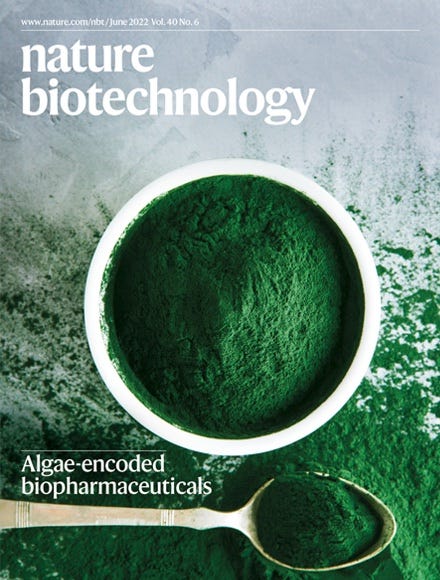
Results
To do this, the team integrated various exogenous genes into the spirulina chromosome by markerless homologous recombination, before evaluating the stable, high-level expression of several therapeutic proteins including bioactive peptides, single-chain antibodies, enzymes, signaling proteins and vaccine antigens.
And?
They discovered several methods that allow constitutive and stable expression of protein therapeutics in spirulina with productivities and potencies tens to hundreds of fold higher than achievable in other food-based platforms.
Amazingly, these advances in scalability and potency make orally delivered biologics commercially feasible for the first time.
And here’s what Jim Roberts, M.D., Ph.D., Chief Scientific Officer of Lumen Bioscience had to say:
Delivering therapeutic amounts of protein biologics to the intestine presents an enormous challenge, and for this reason targets in the GI tract have long been considered almost undruggable.
The spirulina platform elegantly addresses this challenge. It can be used to produce and deliver the enormous quantities of ingestible biotherapeutics that will be needed to both prevent and treat gastrointestinal diseases. Preventing and treating diarrheal disease, the example reported in today’s paper, offers an excellent case study: these highly prevalent diseases have devastating impacts in the developing world, but traditional drug-making tools have failed to generate a solution despite decades of heavy investment. The approach described in our publication offers new hope to the individuals exposed to these diseases.
The publication also details favourable preclinical and early-stage clinical testing of these products against campylobacter, a major cause of infant mortality in the developing world and a growing antibiotic resistance threat. The product, LMN-101, is now proceeding through Phase 2 clinical trials, and BARDA’s CARB-X program is funding development of a second-generation version.
🔥 What else was hot in algae-tech this week?
- (Paper) Sampling a gradient of red snow algae bloom density reveals novel connections between microbial communities and environmental features: This team examines associations of microbial communities and environmental measures between/within snow algae blooms. Snows from the Cascade Mountains and the Rocky Mountains (USA) were collected from medial (M), peripheral (P), and adjacent (A) zones of red snow algae blooms. Medial snow shows increased levels of pollen, lower oxidation–reduction potential, decreased algal and increased bacterial richness, and increased levels of potassium when compared to A and P within the same bloom.(Nature)
- Oceans Offer a Revolution in Farming. See here an interview with Paul Dobbins, Senior Director of Impact Investing and Ecosystems Services, Aquaculture at World Wildlife Fund. He is identifying companies for impact investment, stakeholder collaboration, and research opportunities that will accelerate the growth of seaweed and shellfish farming. His project, titled Advancing Aquaculture for Climate Gains, includes research into the potential market for feed additives for ruminants and the development of new markets for seaweed biomass.
- Phytonix: Converting CO2 Emissions into Sustainable Solar Chemicals & Fuels. Bruce Dannenberg founded his company Phytonix in 2009 after working in the renewable energy industry for many years. Familiar with a variety of bio-based technologies, he saw a lot of energy production efforts operating at high costs and low volume, thus never likely to be feasible or commercially sustainable. Then, around 2008, the field of synthetic biology emerged, and since then, Phytonix has been diving headfirst into the world of synthetic biology to sustainably produce cleaner energy, utilising photosynthetic microorganisms while reducing harmful CO2 emissions. (Read more HERE)
- Running Tide is facing scientist departures and growing concerns over seaweed sinking for carbon removal. The venture-backed startup believes kelp could be a powerful tool to combat climate change. But some scientists fear the ecological risks on large scales.
- (Paper) Rhodopsin-bestrophin fusion proteins from unicellular algae form gigantic pentameric ion channels: This study reports the discovery, structure and biophysical characterization of bestrhodopsins, a microbial rhodopsin subfamily from marine unicellular algae, in which one rhodopsin domain of eight transmembrane helices or, more often, two such domains in tandem, are C-terminally fused to a bestrophin channel.(Read more HERE)
- Madrid Food Innovation Hub, the leading center for entrepreneurship in Madrid, selected 12 startups in its first Foodtech accelerator program. Some algae teams include Origin Algae and Cianoalgae. (Read more HERE)
- Scientists to Develop New Seafood by Fusing Fungi and Seaweed With Alchemist Michelin Chefs. The project, headed by Dr Leonie Jahn from the Technical University of Denmark and Diego Prago, head of research at Alchemist, will see the chefs experiment with fungi to eventually create whole-cut seafood by using the fungi to ferment seaweed. If successful, the product may be sold at the restaurant and could go on to be widely available for purchase. (Read more HERE).
- Preparing for an algal galaxy quest: Dr Matthew Davey of SAMS is investigating the use of algae in space by selecting the most suitable strains for a hypothetical mission to Mars.(Read more HERE).
- Seaweed and 3D printers: Chile’s innovative approach to feeding kids. Some dehydrated “cochayuyo” seaweed, some instant mashed potatoes and hot water: these are the ingredients for a nutritious menu of 3D printed food that nutritional experts in Chile hope will revolutionise the food market, particularly for children.(Read more HERE).
- Scientists probe link between ‘snow blood’ and climate change. Standing on a snowy mountainside about 2,500 metres above sea level, Eric Marechal holds up a crimson test-tube. Inside is an algae sample known as “snow blood,” a phenomenon that accelerates Alpine thaw and that scientists worry is spreading. “These algae are green. But when it’s in the snow, it accumulates a little pigment like sunscreen to protect itself,” said Marechal, research director at Grenoble’s Scientific Research National Center, who was collecting laboratory samples on Le Brevent mountain with teammates. (Read more HERE).
- (Paper) Comparative transcriptomics reveals the molecular toolkit used by an algivorous protist for cell wall perforation. This team used the flagellate Orciraptor agilis (Viridiraptoridae, Rhizaria) as a model protoplast feeder and applied differential gene expression analysis to examine its penetration of green algal cell walls. They found lytic carbohydrate-active enzymes that are highly expressed and upregulated during the attack on the alga. (Read more HERE).
🐦Tweet of the week
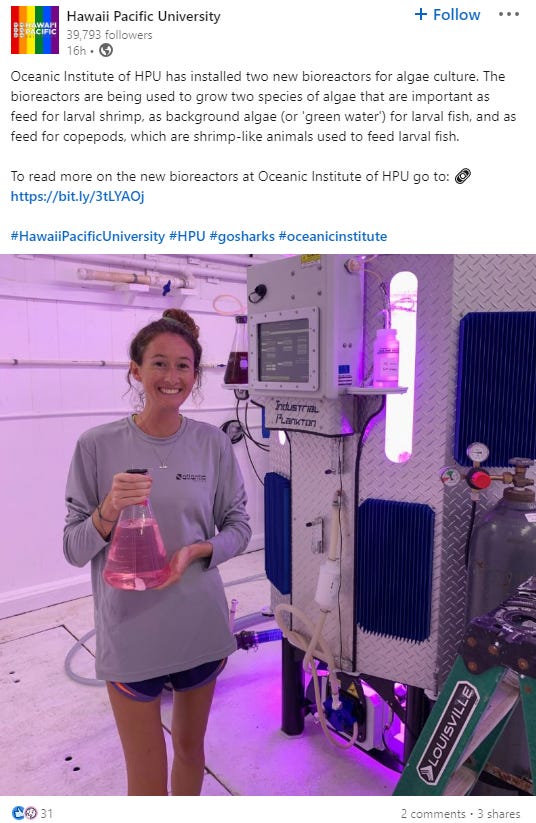
That’s all folks!
Thanks again for joining us this week. Hope you have a great day and stay tuned for more algae tech updates soon!
Peter


